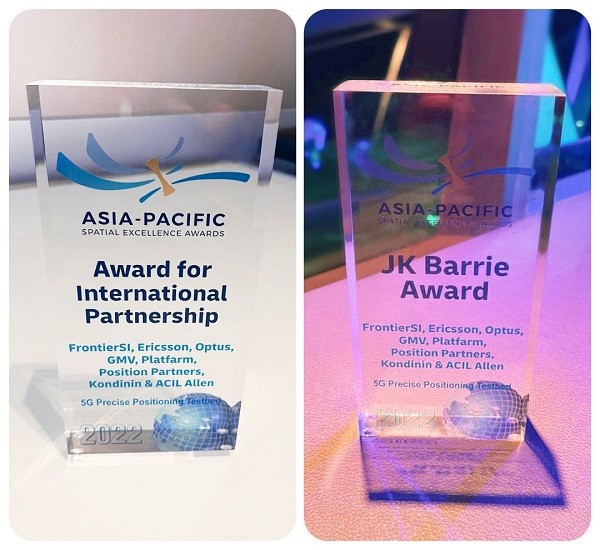GMV's high-precision 5G positioning in Australia, winner of the Asia-Pacific Spatial Excellence awards

The 5G precise positioning testbed project, carried out by the technology consortium comprising GMV, FrontierSI, Ericsson and Optus and its demo partners Kondinin, Platfarm and Position Partners, won the International Partnership award at the Asia-Pacific National Space Excellence Awards dinner in May. In addition, the project also received the prestigious J.K. Barrie Award, which recognizes Keith Barrie's selfless contribution to the professional and business communities, representing the most valuable award the panel of judges can bestow. Jess David Calle Calle, Division Head Algorithms and Positioning Services at GMV, and Adrián Chamorro Moreno,Positioning Engine Product Manager, received both awards on behalf of GMV.
The 5G Precise Positioning Testbed project aims to demonstrate the capabilities of the 5G-based LTE Positioning Protocol (LPP) in tests in real-world environments and use cases as part of the 5G Positioning Testbed, a project funded through the Australian Government's 5G Innovation Initiative.
The results obtained thus far are a crucial breakthrough for the use of 5G technology in high-precision positioning. The test suite demonstrated the capabilities of each of the 5G LPP operating modes for high-precision GNSS-based services, including OSR (Observation Space Representation), SSR (State Space Representation), and SSR with atmospheric corrections. The tests have been performed on real use cases and with equipment provided by the partners to study the technical feasibility in a number of applications. Field tests showed that the solution can achieve centimeter accuracy with fast convergence times using a commercial receiver and antenna.
GNSS-based precise positioning is currently the most widely used technology for calculating absolute positions at the user level. In cases where centimeter accuracy is required, GNSS corrections are necessary to reduce the typical errors that occur in the broadcast navigation message and position calculation. For years, the distribution of GNSS corrections has been based either on PPP (Precise Point Positioning), or RTK (Real Time Kinematics) corrections distributed via geostationary (GEO) satellites over the L-band, or on point-to-point transmissions via NTRIP over the Internet. Both options have their drawbacks: broadcasting via GEO satellites requires a complex ground infrastructure and maintenance costs are often high, and the distribution of NTRIP (Networked Transport of RTCM via Internet Protocol) is not scalable due to the point-to-point connections required for each user.